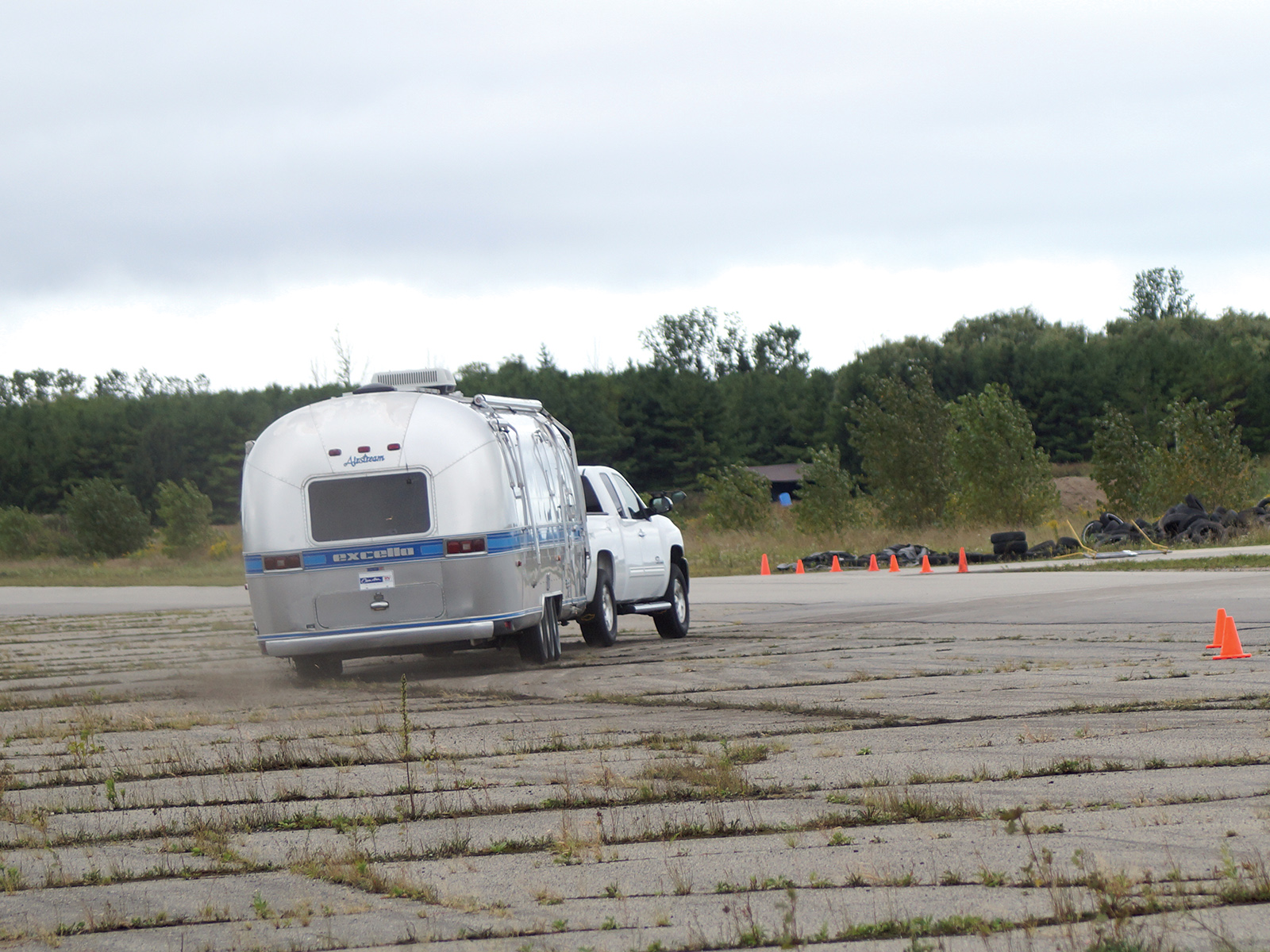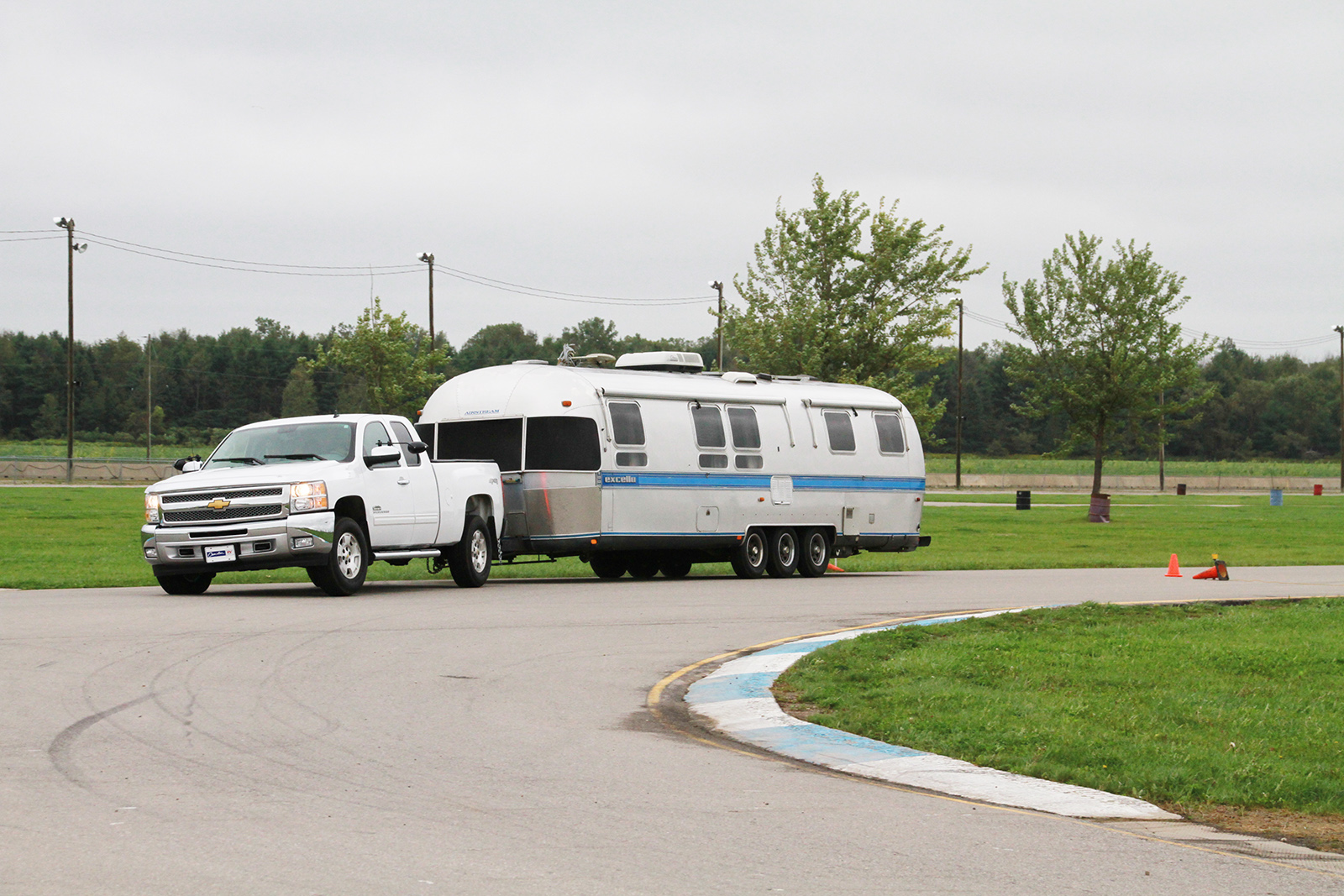Mysteries of the SAE J2807 Tow Rating Standard
By Andy Thomson
For RV owners, one of the most important factors in safe and enjoyable towing is the proper adjustment of the torsion bars that distribute the weight between the trailer and the tow vehicle. When properly set-up, the torsion bars will lever some of the weight of the trailer onto the front wheels of the tow vehicle, which helps to level the tow vehicle/trailer combination and enhances steering, braking, and stability of the rig.
In previous articles we discussed how to set your torsion bars properly. Here is a quick summary of the process.
1. To set the torsion bars you need to park on a level cement pad. You want the trailer and tow vehicle in a straight line, disconnected, with the coupler ready to drop on the ball.
2. With the tow vehicle in position, but disconnected from the trailer, use some masking tape and measure the height from the ground to the four corners of the tow vehicle. Mark the tape with these measurements, for example 22 inches, or whatever is appropriate for your tow vehicle.
3. Now that we know how the tow vehicle sits without the trailer, we want to determine the change in position when the trailer is connected.
4. Connect the trailer and do up the torsion bars. Take note of the change in height at each corner of the tow vehicle, and mark this on the masking tape.
5. You will find that the tow vehicle will have been pushed down by the weight of the trailer. For example, the rear measurement may now be 20” instead of 22” but the front may have come up to 22.5”. In this case, you need to go up to the next link in the torsion bar adjustment chain (adding tension to the torsion bars) and measure again.
6. You may find that the next link puts you into the opposite position, where the front is pushed down 1” and the back stays even at the 22” mark. This means that the torsion bars are transferring too much weight forward.
7. If this is the case you need a partial link. To do that, overlap two chain links and slide a ½” bolt through them. A ½” bolt is 1/3 of a link of adjustment so in some cases you will need 2 bolts to achieve the correct transfer.
8. When properly adjusted, the torsion bars will put enough weight on all four wheels to lower the corners of the tow vehicle from the “22 inch” starting point to between 21 ¼” and 21 ½” front and rear.
9. If you are setting up a new hitch, the torsion bars will wear in quite quickly. You will likely need to add a third of a link after 200-500 miles. You will need another third of a link after another 500-1000 miles. You will probably feel the difference in the steering response of the tow vehicle as the new torsion bars “wear in”. It is fine to experiment by adding or subtracting 1/3 of a link at a time, and you should notice the difference in steering feel right away if it was the right or wrong change to make.
10. If you can’t get the weight to transfer to the front wheels without your torsion bars meeting the trailer frame, then you don’t have enough reward angle on your ball mount, or the torsion bars are too light, you may have a hitch receiver that is too weak, or all of the above.
This is how we have configured hitches for the past 45 years. Because of these articles and internet searches, people with towing stability problems regularly seek us out. This is how we wind up helping them most of the time. A couple of hundred times every year we reconfigure a problem hitch to these new settings. The difference is usually quite dramatic and customers are quite pleased.
The SAE (Society of Automotive Engineers) has been working on a tow rating standard that they can use to better determine a vehicle’s tow rating. The standard will be better than nothing, but it will still have many issues, the main one being that it is dependent on weight alone. The issue that concerns me most is that the SAE have come out with a recommendation on how to adjust torsion bars that in my experience is quite flawed.
Most vehicle manufacturers use enclosed cargo trailers with test weights inside for tow testing. This gives the cargo trailers a low center of gravity, and most of them use torsion axle suspensions. Connect a tall RV trailer with a slide-out, leaf springs and no shocks, and those handling tests are no longer meaningful. In a crosswind a tall RV trailer will behave much worse than a cargo trailer, however the SAE did no testing on crosswind effects and really how could they? However, most loss-of-control trailer accidents are the result of sudden wind changes.
The next barrier to effective testing is another SAE standard that we discussed in previous issues. Many of the vehicles being tested have hitch receivers that are too weak to transfer weight properly. If you cannot set up the hitch optimally how can you perform a good handling test? And most of the testing appears to be done with little or no rearward angle on the ball mount so the weight transfer on the tow vehicles is wrong. Without angle on the ball mount when turning, weight is taken off the front wheels and inside rear wheel and all dumped on the outside rear wheel. Last but not least, the testing was done with the ball positioned well behind the bumper, and no effort was made to reduce overhang. The bottom line is that they never tested a truly dialed-in hitch system.
The next concern with J2807 is the handling tests themselves. One involves a test where travelling at highway speed, the steering wheel is snapped 180 degrees and immediately snapped back to the straight ahead position. The problem with this test is that there is no correction for steering gear ratio or wheelbase. In a vehicle with a short wheelbase and a quick steering ratio this is a very violent maneuver, whereas in a long wheelbase vehicle with a slow steering gear it’s relatively relaxed.

The second SAE handling test is a steady state circle around the skid pad. As the G force increases, the tow vehicle will start to go outside the circle, and either the back end will break loose (oversteer) or the front tires will plow (understeer). Car companies like understeer. Now my own testing of this is takes place on a delightful exit ramp with a downhill decreasing radius turn. What I find with my combinations is that the front end will almost always start to plow first, but if you overcorrect (which is the tendency) then the back end will come around. If you just let it drift a little, it pretty smoothly continues around the ramp drifting a slight bit off line. In the SAE test they kept breaking the back end loose, which is to be expected since their hitch set up was unloading the inside rear tire and overloading the outside rear.
This combination of events led them to recommend a strange way of adjusting a weight distribution hitch. Instead of setting the hitch to push the tow vehicle down the same amount front and rear they use another method. Measure the height of the front of the tow vehicle. Drop the trailer on the ball without torsion bars. Measure again. Let’s say the front raises 2” then they want you to set the torsion bars so the front raises 50% from its solo position or in this case 1” higher than its solo position. This results in a considerable unloading of the steering axle. If you set your combination up this way it will be quite unstable at highway speeds especially when there is truck turbulence or crosswinds.
In theory, it would have a little more traction decelerating into low speed sharp turns. I have never seen an accident that was at all serious on a low speed sharp turn but there have been plenty due to loss of control at highway speed. After the SAE came out with this I thought that possibly we’ve been wrong for 40 years. I tried setting up some combinations with their method and none of them were what I would consider stable at highway speeds. In fact, most of the 200 trailers a year that we fix for people come in close to the SAE spec, usually due to a combination of weak receivers and improperly set ball mounts.
Before writing this column I wanted some more track testing just to check again that there was not something I was missing. I felt I should use a pick up as that is what the SAE used mostly in their testing. We used a ½ ton GM truck with a 34’ Airstream for testing. We tested it to the industry spec where the truck is pushed down evenly and to the suggested SAE spec. Two differences from the SAE testing were that our ball was as close to the bumper as possible and we strengthened the stock hitch receiver. In their test the back axle lost traction with the industry specification. In the 100’ slalom we achieved 81 KPH with the hitch set to our spec, 81 KPH is really moving in the slalom. At the sixth cone the Airstream drifts sideways on all six tires which is no easy feat. In theory if the back tires were to break loose on the truck this is where it should happen when the trailer is sliding sideways, but the truck stayed planted and slid very little if at all. When we tried the same speed with the SAE spec we made it to the second cone and had to give up the run due to lack of control. On the track there is a nice declining radius turn where we expected the SAE spec truck to do better, but there was no speed difference to speak of, on both settings the front tires started to plow before the back wheels broke loose. Next we tried a steady state turn that took us down and then up a lip of asphalt as well as over several bumps with less sticky pavement. The SAE setting bounced more and felt less planted, but again we could not measure any appreciable difference in speed. I think that most drivers would find it much easier with the industry spec.
I have the greatest respect for the SAE. What the auto industry has accomplished is nothing short of amazing, and the technologies reach far beyond the car industry. I think in this case the SAE has tried to take on something that should not be their job. Then whose job is it? I believe it should be the RV dealer. The dealer is the only one who sees the trailer, vehicle and hitch system and who also meets the driver and understands how he’s going to use the combination. But since many RV dealers are afraid to get involved over fear of lawsuits etc. the towing equation tends to be neglected. In fairness, if we didn’t have a 45-year track record I doubt we would do what we do either. The good news is you don’t have to take my word for any of this. It’s easy to experiment with your own combination. Set it up to both specs and try it each way and you can decide for yourself if the industry spec of the last 50 years is right or if the SAE spec works better for you.
In the end, getting the right combination and making sure it is configured properly is often up to you. That’s why you need to look beyond tow ratings and weight, and focus on the core principles behind the design of the tow vehicle and the trailer. Of course never compromise your hitch set up!























